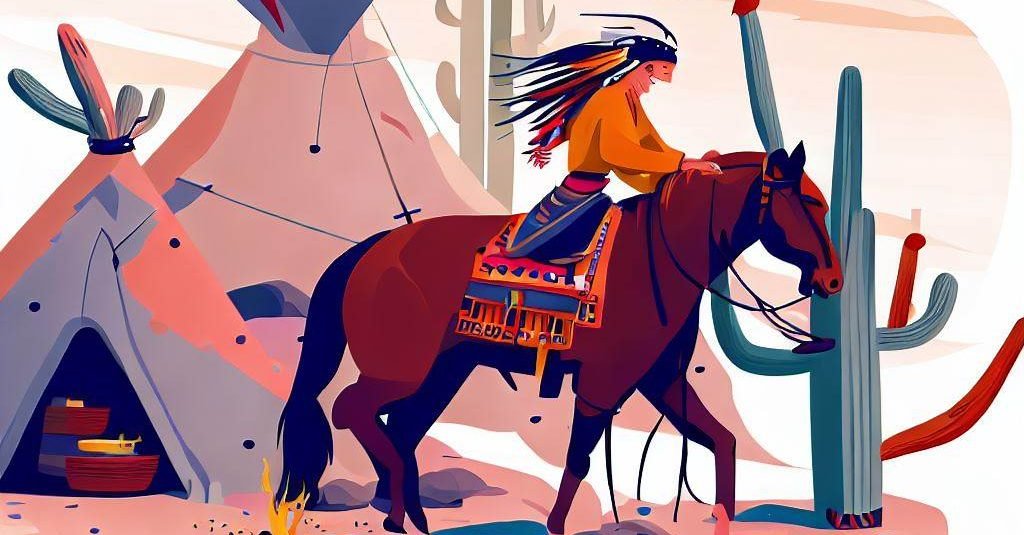The Chiricahua Apache: History, Culture, and Notable Leaders
The Chiricahua Apache are a Native American tribe known for their fierce resistance against colonial powers, their strong connection to their ancestral lands, and their rich cultural heritage. This article explores the interconnected history, culture, and society of the Chiricahua Apache, highlighting the tribe’s notable leaders, their interactions with neighboring tribes and peoples, and their ongoing struggles in the modern era.
The Chiricahua Apache are one of several Apache tribes that historically inhabited the southwestern United States and northern Mexico. Their traditional territory extended across present-day Arizona, New Mexico, and the Mexican states of Sonora and Chihuahua. The Chiricahua Apache were composed of four main groups: the Chokonen, the Chihenne, the Bedonkohe, and the Nednai. These groups maintained strong connections to their ancestral lands and relied on hunting, gathering, and limited agriculture for subsistence. Their culture is characterized by complex social and spiritual practices, as well as a deep respect for the natural world.
Cultural and Spiritual Practices
The Chiricahua Apache placed great importance on their spiritual beliefs, which were closely tied to their natural surroundings. They believed in a supreme being called Usen, as well as other spiritual entities that inhabited the land, sky, and water. Rituals and ceremonies played a central role in their daily lives, with practices such as the puberty ceremony for girls and the ceremonial use of peyote in religious contexts.
Their social structure was based on local bands led by influential leaders, who were often chosen for their wisdom, generosity, and courage. Family ties, including extended kinship networks, were of great importance, providing support and a sense of belonging for individual members.
The Chiricahua Apache have made significant cultural contributions to the southwestern United States and northern Mexico, influencing the history and culture of these regions. Their artistic expressions, including beadwork, basketry, pottery, and textiles, reflect their unique heritage and display their skill in craftsmanship. These traditional art forms continue to be practiced and appreciated today, both within the Chiricahua Apache community and beyond.
Their influence can also be seen in the blending of cultures that has taken place in the region. The Chiricahua Apache have contributed to the development of the distinct Southwestern and Mexican cultures, where elements of Native American, Spanish, and later, American traditions have intermingled. This rich cultural tapestry is evident in the cuisine, music, and folk art that characterize the region today.
Early History and Intertribal Relations
Before European colonization, the Chiricahua Apache had a complex social and political organization based on local bands led by influential leaders. These bands interacted with neighboring tribes, such as the Pueblo, Navajo, and other Apache groups, through trade, intermarriage, and conflict. The Chiricahua Apache often formed alliances with other tribes to defend their territories and resources against intruders. For instance, the Chiricahua Apache and Navajo occasionally joined forces against common enemies, despite their own history of conflict.
Colonial Period and Spanish Contact
With the arrival of the Spanish in the 16th century, the Chiricahua Apache faced new challenges, including the introduction of diseases, forced labor, and territorial encroachment. Despite these pressures, the Chiricahua Apache maintained their autonomy and resisted Spanish attempts at assimilation and conversion to Christianity. They also adopted horses and firearms, which transformed their way of life and enabled them to become highly skilled mounted warriors.
The Chiricahua Apache first encountered Europeans in the 16th century when Spanish explorers entered their territory, which spanned modern-day Arizona, New Mexico, and parts of Mexico. As Spanish settlements expanded into the Southwest, tensions between the Chiricahua and the Spanish grew. Throughout the 17th and 18th centuries, the Apache engaged in sporadic conflicts and skirmishes with Spanish colonizers, often launching raids on settlements and missions.
Following Mexico’s independence from Spain in 1821, the relationship between the Chiricahua Apache and the Mexican government remained contentious. With Mexican authorities offering bounties for Apache scalps, the Chiricahua defended their territory through raids and guerrilla warfare. The United States’ westward expansion in the mid-19th century further complicated matters, as it led to the Mexican-American War (1846-1848) and the subsequent transfer of large portions of Apache territory to the United States.
Reservation Period and Forced Relocation
As the United States government sought to contain and control Native American tribes in the newly acquired territories, they established reservations and initiated a series of treaties with the Chiricahua Apache. However, these agreements were often poorly enforced, leading to widespread distrust and ongoing hostilities. Prominent Apache leaders, such as Cochise and Geronimo, fought to resist U.S. expansion and protect their people’s way of life.
Ultimately, in 1886, the U.S. Army captured Geronimo and his band, marking the end of the Chiricahua Apache’s armed resistance. The tribe was forcibly removed from their ancestral lands and relocated to various reservations in the Southwest, including the infamous Fort Sill in Oklahoma. These forced relocations led to significant cultural disruption and the erosion of traditional Apache lifeways.
Notable Leaders
Throughout their history, the Chiricahua Apache produced many notable leaders who played crucial roles in defending their lands and people. Some of the most famous Chiricahua Apache leaders include:
- Cochise: The Chokonen chief who led his people in resistance against the encroachment of American settlers and the U.S. Army in the 1860s and 1870s. Cochise was known for his military prowess and diplomacy, eventually securing a reservation for his people in their traditional homeland.
- Geronimo: A Bedonkohe Apache warrior and leader, Geronimo fought against both Mexican and U.S. forces in the late 19th century. He became a symbol of Native American resistance and was eventually captured by U.S. forces in 1886, marking the end of the Apache Wars.
- Lozen: A skilled warrior, spiritual leader, and sister of the Chihenne chief Victorio, Lozen fought alongside her brother in battles against U.S. and Mexican forces. Her military skills and spiritual power earned her great respect among her people.
- Mangas Coloradas: A prominent leader of the Chihenne band, Mangas Coloradas fought against Mexican and U.S. forces in the early to mid-19th century. He was known for his tactical brilliance and efforts to unite the Apache tribes against their common enemies.
Contemporary Challenges and Ongoing Struggles
The Chiricahua Apache’s struggles with land rights, cultural preservation, and the impact of government policies remain relevant today.
For instance, following the end of the Apache Wars, many Chiricahua Apache were forcibly removed from their homelands and relocated to reservations in Oklahoma and New Mexico. This displacement had lasting effects on the tribe’s connection to their ancestral lands, as well as their cultural and spiritual practices.
Additionally, the Chiricahua Apache have faced ongoing challenges in preserving their culture and language. Many tribal members are working tirelessly to revitalize their language and pass on traditional knowledge to younger generations.
Efforts to achieve recognition and self-determination for the Chiricahua Apache have been met with varying degrees of success. The tribe has been involved in numerous legal battles to regain control over their ancestral lands and secure resources for their community.
Conclusion
The Chiricahua Apache have a rich history marked by their strong connection to their ancestral lands, their notable leaders, and their interactions with other tribes and peoples. Their resilience in the face of colonial pressures and the leadership of figures like Cochise, Geronimo, Lozen, and Mangas Coloradas enabled them to maintain their autonomy and cultural identity for centuries. However, their story is not limited to their past; the Chiricahua Apache continue to face challenges in the modern era, including struggles with land rights, cultural preservation, and government policies. Understanding the full scope of their history and present-day situation offers valuable insights into the strength and determination of the Apache people.
Suggested Further Reading:
- Baldwin, Gordon C. (1965) The Warrior Apaches: A Story of the Chiricahua and Western Apaches. Tucson: King Press.
- Ball, Eve. (1970) In the Days of Victorio: Recollections of a Warm Springs Apache. Tucson: University of Arizona Press.
- Haley, James (1983). Apaches: A History and Culture Portrait. New York: Doubleday.
- Santee, Ross (1971). Apache Land. Lincoln: University of Nebraska Press.
- Stockel, H. Henrietta (1991). Women of the Apache Nation: Voices of Truth. Reno: University of Nevada Press.

